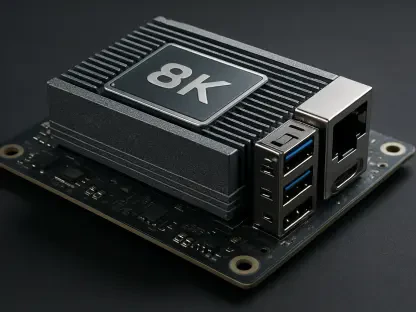In a world increasingly reliant on digital infrastructure, blockchain technology stands at the forefront as a game-changer; nonetheless, its potential is often hindered by inherent scalability limitations. Known for its promise of decentralization and transparency, blockchain faces significant challenges, particularly when it comes to managing large transaction volumes efficiently. As the demand for blockchain applications continues to surge, especially within the Web3 ecosystem, solutions addressing these scalability issues have become paramount. Enter the Waterfall Network, a pioneering advancement in blockchain technology aiming to transcend these long-standing challenges. This revolutionary solution employs Directed Acyclic Graph (DAG) technology to reshape how blockchain networks function. With an impressive transaction capacity of over 12,777 transactions per second (TPS), Waterfall Network is setting new benchmarks, leaving traditional systems in its wake. Against the backdrop of evolving digital demands, this innovative approach stands as a beacon of hope for enterprises, startups, and developers seeking to capitalize on blockchain’s full potential.
Unpacking the Waterfall Network Architecture
The architecture of the Waterfall Network is its distinguishing feature, showcasing an impressive strategy in tackling blockchain scalability issues. Unlike conventional linear blockchain frameworks, Waterfall leverages the non-linear DAG structure, facilitating simultaneous transaction processing. This architectural choice significantly minimizes bottlenecks and accelerates transaction speeds, resulting in a remarkable throughput that surpasses many competitors. Moreover, Waterfall Network supports an inclusive ecosystem of 1.5 million lightweight nodes, enhancing decentralization and network resilience. This inclusivity means that a broader array of participants can contribute without the need for heavy resource investments. By enabling efficient transaction processing without compromising the network’s integrity, Waterfall Network has engineered a scalable solution that is as inclusive as it is robust. The DAG framework underpins these advancements, providing an optimized environment that redefines blockchain interactions. Through advanced fractal sharding, resources are distributed effectively, allowing each shard to maintain near-autonomous operations while remaining synchronized with the global state of the network. This innovative approach not only promotes efficiency but also ensures security, delivering a cohesive solution to scalability challenges.
A critical component of the Waterfall Network’s effectiveness is its emphasis on validator accessibility. Validators are crucial to maintaining the network’s performance and security, and Waterfall Network has lowered the entry barriers to validator participation. By requiring minimal hardware resources—a mere 2-core CPU and 8GB of RAM—this network invites a diverse group of participants, fostering decentralization and fortifying the system’s security posture. This is a stark departure from other blockchain networks that demand extensive infrastructure and resources, often limiting participation to those with significant technical capability and capital. With Waterfall Network’s inclusive validator approach, the blockchain landscape opens up to a wider demographic, ensuring that security and performance are upheld in community-driven ways. This is a vital step in promoting a healthy, decentralized ecosystem where diverse voices and entities can collaborate to shape the future of blockchain technologies collectively.
Transformative Impact on Web3 Startups
Web3 startups are navigating an intricate and rapidly evolving digital landscape, and the Waterfall Network emerges as a potential game-changer for these burgeoning enterprises. Many startups find themselves constrained by obsolete financial infrastructures, struggling to align their innovative visions with the limitations of current blockchain systems. The advanced scalability solutions offered by Waterfall Network promise to break these chains, offering a fresh outlook for these companies. By simplifying transaction processes and efficiently managing resource allocation, this network propels startups toward smoother operations, enhanced adaptability, and greater financial interoperability. With its capacity to process a high volume of transactions concurrently, Waterfall Network also holds the potential to transform decentralized finance (DeFi) and the broader Web3 landscape.
In practical terms, Waterfall Network provides Web3 startups with the tools to merge traditional financial systems with cryptocurrency ecosystems seamlessly. This integration is vital for startups aiming to bridge the gap between new and existing financial paradigms. The scalability of Waterfall Network means these companies can confidently navigate regulatory landscapes, find innovative solutions to compliance issues, and maintain competitiveness in an increasingly digitized market. For Web3 companies, achieving the delicate balance between leveraging cutting-edge technological infrastructure and ensuring regulatory adherence is crucial. The Waterfall Network, with its architectural innovations, creates an environment where startups can focus on creativity and expansion without becoming entangled in the complexities of scalability limitations. This network is not merely a solution but a strategic enabler, offering newfound freedom and opportunities for startups determined to disrupt and redefine industries through blockchain technology.
Navigating the Future of Decentralized Finance
The Waterfall Network’s introduction into the blockchain ecosystem signifies a pivotal moment for the future of decentralized finance (DeFi) and digital currency. As the crypto industry continues its dynamic expansion, networks that integrate scalability enhancements seamlessly with decentralization principles are essential for sustainable growth. Waterfall’s innovative use of DAG architecture combined with its accessible validator framework sets the stage for a more inclusive and effective digital economy. The implications for the crypto market are far-reaching, sparking interest from developers and organizations alike seeking to harness the power of this evolving technology. By delivering a framework that optimizes transaction throughput while maintaining decentralization, the Waterfall Network provides a viable pathway for widespread blockchain adoption across industries.
Yet, beyond scalability, Waterfall Network holds promise in fostering innovation within the ever-evolving landscape of blockchain applications. By mitigating bottlenecks and reducing processing times and fees, it empowers enterprises to explore new use cases and business models. The potential for fostering new avenues of innovation is limitless, from smart contracts and supply chain solutions to novel decentralized applications (dApps). As stakeholders delve into these opportunities, the focus shifts from traditionally conservative approaches to progressive paradigms driven by cutting-edge infrastructure. In this context, the Waterfall Network not only revolutionizes scalability but also inspires confidence in a decentralized future, motivating stakeholders to embrace changes and propel developments within their respective fields.
Embracing Technological Evolution
In today’s world, where digital infrastructure plays a crucial role, blockchain technology has emerged as a transformative force. Despite its potential to decentralize and provide transparency, blockchain often struggles with scalability issues. These challenges become particularly evident when it comes to efficiently handling large transaction volumes. As the interest in blockchain applications, especially within the Web3 arena, continues to grow, addressing scalability hurdles has become essential. Introducing the Waterfall Network, an innovative leap in blockchain technology designed to overcome these persistent challenges. This groundbreaking solution utilizes Directed Acyclic Graph (DAG) technology to redefine how blockchain networks operate. With an exceptional ability to process over 12,777 transactions per second (TPS), Waterfall Network is pushing traditional systems to the sidelines. Amid burgeoning digital demands, this forward-thinking approach offers a ray of hope for businesses, startups, and developers eager to unlock the full promise of blockchain technology.









